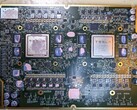The self-driving processor game of electric car manufacturers is developing leaps and bounds, and NIO just unveiled a homebrew chip that carries the power of four Nvidia Drive Orin processors. Called the Shenji NX9031, two of those new processors will replace the usual Orin chips in NIO's upcoming luxury ET9 sedan.
The Shenji NX9031 is built on a modern 5nm production process and carries more than 50 billion transistors, putting NIO's cars at a genuine advantage before the competition. The newly formed chip division of NIO is headed by someone who worked on Oppo and Xiaomi's hardware efforts and its goals are nothing short of ambitious.
Its debut edition supports up to 32 processor cores and 8GB LPDDR5X RAM, and returns a performance benchmark of over 600,000 DMIPS. All that neural network processing of live input from the multiple cameras and sensors on the NIO ET9 comes with redundancies in the form of a second Shenji NX9031 processor in case the first one gives up the ghost for some reason.
Powerful automotive chipsets like the Shenji NX9031 are no strangers to controversy stemming from their significant power consumption, regardless of whether they are built on a frugal 5nm process or not. According to a recent research paper authored by the MIT graduate student in aeronautics and astronautics Soumya Sudhakar:
If we just keep the business-as-usual trends in decarbonization and the current rate of hardware efficiency improvements, it doesn’t seem like it is going to be enough to constrain the emissions from computing onboard autonomous vehicles. This has the potential to become an enormous problem. But if we get ahead of it, we could design more efficient autonomous vehicles that have a smaller carbon footprint from the start.



















